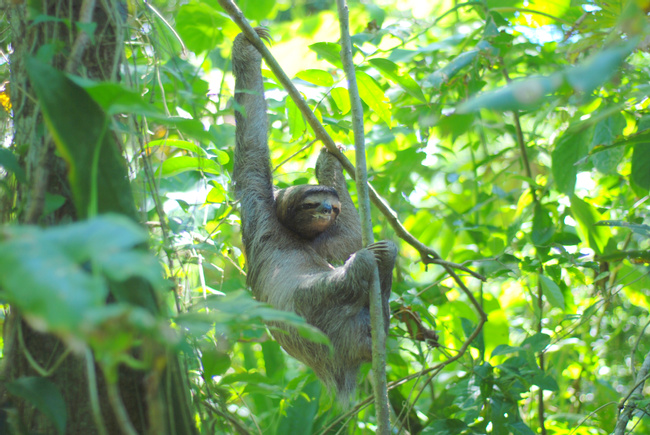
More about Three-Toed Sloth
Habitat
The three-toed sloth prefers tropical evergreen forests at low elevations that have continuous canopy cover.
Range
This sloth species is found from southern Honduras through Panama and western Colombia through the Amazon to northern Argentina.
Physical Description
The three-toed sloth has long coarse hair over dense underfur, a white face with a brown stripe on each side, a brown throat, and a body that is pale brown to yellowish. Each adult male has a unique pattern of yellow hair on its back with a black stripe through the center. As the name suggests, the three-toed has three toes on each of its front and hind feet. (Its relative, the two-toed sloth (Choloepus hoffmanni) also has three toes on the hind feet, but two on the front feet.)
Interesting Biology
The three-toed sloth is active during the day, unlike the nocturnal two-toed sloth, and so is seen more often. This sloth only eats leaves from trees and lianas, but may feed on fifty individual trees of up to thirty species, eating leaves of different ages. Sloths live, feed, mate, and reproduce near the upper levels of the forest canopy. They move to a new tree often enough to balance their diet, or about once every 1.5 days. Home ranges of different individuals may overlap considerably and females tend to be more social than males, but usually one adult (or female with young) will occupy a tree at any given time. Sloths may use different food sources depending upon what their mothers taught them to eat.
Though large for an arboreal mammal, the three-toed sloth must also be light for its size to live in the treetops, so it has reduced muscle mass. They also have an enormous gut capacity-nearly 30% of their body weight! The sloth's diet of leaves is digested very slowly, so they need a large capacity. Sloths consume a significant amount of leaf material in a forest (about 2% of total annual leaf production in Panama). They have a slow metabolism, though, so they have thick fur to insulate them when their body temperature drops at night; their temperature peaks during the day when they bask in the sunlight.
About once a week, the sloth descends from its lofty living space, digs a small hole with its stubby tail, defecates and urinates in the hole, then covers it with leaves using its hind legs and return to its preferred heights. This ordeal lasts less than 30 minutes, but during this time the sloth is vulnerable to predators. While mortality of young sloths is high, individuals that survive to adulthood suffer low mortality rates; they are recorded to live as long as 9 to 11 years, and are thought to live as many as 20 to 30 in the wild.
Several kinds of arthropods live as adults on these sloths. These arthropods leave the sloth to deposit their eggs on the sloth's dung; the hatched larvae feed on the dung, pupate, and after they emerge as adults, fly in search for a sloth to live on. A single sloth may carry nine hundred or more beetles and three species of mites.
An adult female spends half the year pregnant and the other half rearing her single offspring. Young sloths can begin eating leaves when they are two weeks old. As the mother carries the young with her, she shows it which trees and lianas are fit to eat within their home range. When the baby is 6 months old, the mother suddenly leaves the young to her home-range and moves to a nearby range. The young and mother maintain contact through vocalizations, and the young continues to use this portion of her range for a while and then departs.
Diet
A three-toed sloth consumes large amounts of leaves from up to thirty species of trees and lianas; the particular species chosen by an individual sloth vary, and are largely affected by what its mother taught it to eat.
Height/Weight
The three-toed sloth can weigh up to 4.3 kg.
Taxonomy
Order: Xenarthra
Family: Bradypodidae
Sources
Eisenberg, John. Mammals of the Neotropics, Vol. 1. The University of Chicago Press: Chicago, 1989.
Janzen, D. H. and D. E. Wilson in Janzen, Daniel H. Costa Rican Natural History. Chicago: University of Chicago Press, 1983.
Montgomery, G. G. in Janzen, Daniel H. Costa Rican Natural History. Chicago: University of Chicago Press, 1983.
Wilson, D. E. in Janzen, Daniel H. Costa Rican Natural History. Chicago: University of Chicago Press, 1983.
-Amy Strieter, Wildlife Writer
Photos:
- LevelsBirder website.
- Wings of Love website.
Three-Toed Sloth Sightings
Similar Profiles
It's more than just having a good time or visiting beautiful places (although that's absolutely a part of it!), it's about being part of a unique experience that stays with you.



